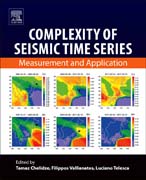
Complexity of Seismic Time Series: Measurement and Application
Chelidze, Tamaz
Vallianatos, Filippos
Telesca, Luciano
Complexity of Seismic Time Series: Measurement and Application applies the tools of nonlinear dynamics to seismic analysis, allowing for the revelation of new details in micro-seismicity, new perspectives in seismic noise, and new tools for prediction of seismic events. The book summarizes both advances and applications in the field, thus meeting the needs of both fundamental and practical seismology. Merging the needs of the classical field and the very modern terms of complexity science, this book covers theory and its application to advanced nonlinear time series tools to investigate Earth's vibrations, making it a valuable tool for seismologists, hazard managers and engineers. Covers the topic of Earth's vibrations involving many different aspects of theoretical and observational seismologyIdentifies applications of advanced nonlinear time series tools for the characterization of these Earth's signalsMerges the needs of geophysics with the applications of complexity theoryDescribes different methodologies to analyze problems, not only in the context of geosciences, but also those associated with different complex systems across disciplines INDICE: 1. Introduction 2. Analysis of Complexity in Seismic Time Sets 3. Fractal, informational and topological methods for the analysis of discrete and continuous seismic time series: an overview 4. Modelling of persistent time series by the nonlinear Langevine equation 5. Point-processes applied to seismology: Epidemic Type Aftershock Sequence (ETAS) model, results and limits 6. Natural Time Analysis of Seismic Time Series 7. Non Extensive statistical Seismology: An overview 8. Triggering and synchronization of seismicity by reservoir loading and strong electromagnetic pulses; a review 9. Complexity and time-dependent SHA: Should we use fuzzy, approximate and prone-to-errors prediction models to overcome the limitations of time-independent models? 10. Are seismogenetic systems random or organized? A treatise of their statistical nature based on the seismicity of the NW Pacific Rim 11. Complexity in Laboratory Seismology. From Electrical and Acoustic Emissions to fracture 12. Four-stage model of earthquake generation in terms of fracture-induced electromagnetic emissions: A review 13. Synchronization of Geophysical Fields Random Fluctuations 14. Complexity and synchronization analysis in natural and dynamically forced stick-slip; a review
- ISBN: 978-0-12-813138-1
- Editorial: Elsevier
- Encuadernacion: Rústica
- Páginas: 420
- Fecha Publicación: 01/06/2018
- Nº Volúmenes: 1
- Idioma: Inglés
